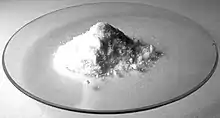Zinc nitrate
Zinc nitrate is an inorganic chemical compound with the formula Zn(NO3)2. This colorless, crystalline salt is highly deliquescent. It is typically encountered as a hexahydrate Zn(NO3)2·6H2O. It is soluble in both water and alcohol.
 | |
 | |
| Names | |
|---|---|
| IUPAC name
Zinc nitrate | |
| Other names
Zinc dinitrate | |
| Identifiers | |
| |
3D model (JSmol) |
|
| ChemSpider | |
| ECHA InfoCard | 100.029.038 |
| EC Number |
|
PubChem CID |
|
| RTECS number |
|
| UNII | |
| UN number | 1514 |
CompTox Dashboard (EPA) |
|
| |
| |
| Properties | |
| Zn(NO3)2 | |
| Molar mass | 189.36 g/mol (anhydrous) 297.49 g/mol (hexahydrate) |
| Appearance | colorless, deliquescent crystals |
| Density | 2.065 g/cm3 (hexahydrate) |
| Melting point | 110 °C (230 °F; 383 K) (anhydrous) 45.5 °C (trihydrate) 36.4 °C (hexahydrate) |
| Boiling point | ~ 125 °C (257 °F; 398 K) decomposes (hexahydrate) |
| 327 g/(100 mL), 40 °C (trihydrate) 184.3 g/(100 mL), 20 °C (hexahydrate) | |
| Solubility | very soluble in alcohol |
| −63.0·10−6 cm3/mol | |
| Hazards | |
| Occupational safety and health (OHS/OSH): | |
Main hazards |
Oxidant, may explode on heating |
| GHS labelling: | |
  | |
| Flash point | Non-flammable |
| Safety data sheet (SDS) | ICSC 1206 |
| Related compounds | |
Other anions |
Zinc sulfate Zinc chloride |
Other cations |
Cadmium nitrate Mercury(II) nitrate |
Related compounds |
Copper(II) nitrate |
Except where otherwise noted, data are given for materials in their standard state (at 25 °C [77 °F], 100 kPa).
Infobox references | |
Synthesis
Zinc nitrate is usually prepared by dissolving zinc metal, zinc oxide, or related materials in nitric acid:
- Zn + 2 HNO3 → Zn(NO3)2 + H2
- ZnO + 2 HNO3 → Zn(NO3)2 + H2O
These reactions are accompanied by the hydration of the zinc nitrate.
The anhydrous salt arises by the reaction of anhydrous zinc chloride with nitrogen dioxide:[1]
- ZnCl2 + 4 NO2 → Zn(NO3)2 + 2 NOCl
Reactions
Treatment of zinc nitrate with acetic anhydride gives zinc acetate.[2]
On heating, zinc nitrate undergoes thermal decomposition to form zinc oxide, nitrogen dioxide and Oxygen:
- 2 Zn(NO3)2 → 2 ZnO + 4 NO2 + 1 O2
Applications
Zinc nitrate has no large scale application but is used on a laboratory scale for the synthesis of coordination polymers.[3] Its controlled decomposition to zinc oxide has also been used for the generation of various ZnO based structures, including nanowires.[4]
It can be used as a mordant in dyeing. An example reaction gives a precipitate of zinc carbonate:
References
- Greenwood, Norman N.; Earnshaw, Alan (1997). Chemistry of the Elements (2nd ed.). Butterworth-Heinemann. p. 455. ISBN 978-0-08-037941-8.
- O. F. Wagenknecht; R. Juza (1963). "Zinc Acetate". In G. Brauer (ed.). Handbook of Preparative Inorganic Chemistry, 2nd Ed. Vol. 2. NY,NY: Academic Press. p. 1087.
- Barnett, Sarah A; Champness, Neil R (November 2003). "Structural diversity of building-blocks in coordination framework synthesis—combining M(NO3)2 junctions and bipyridyl ligands". Coordination Chemistry Reviews. 246 (1–2): 145–168. doi:10.1016/S0010-8545(03)00121-8.
- Greene, Lori E.; Yuhas, Benjamin D.; Law, Matt; Zitoun, David; Yang, Peidong (September 2006). "Solution-Grown Zinc Oxide Nanowires". Inorganic Chemistry. 45 (19): 7535–7543. doi:10.1021/ic0601900. PMID 16961338.